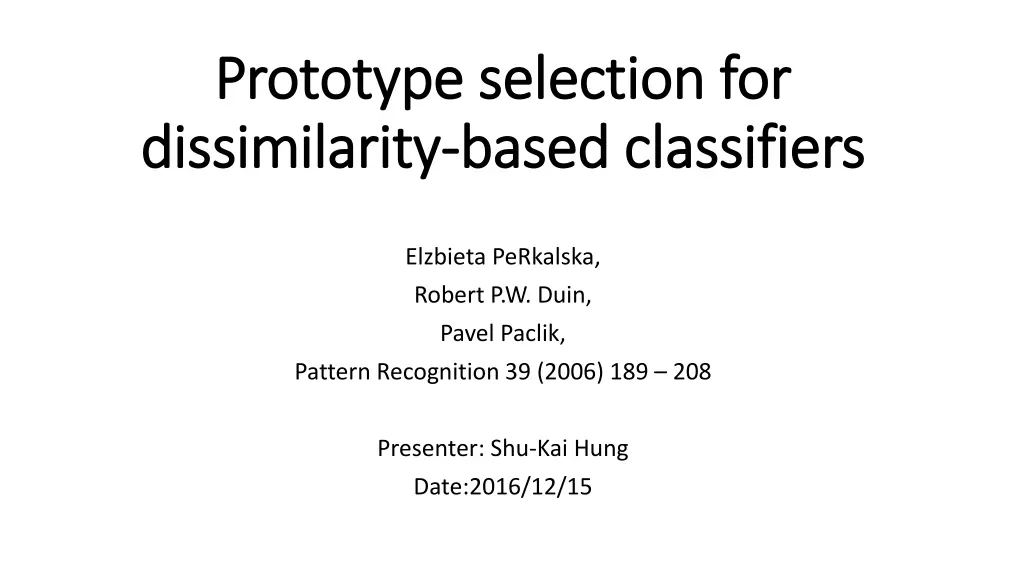
Enhancing Classification Accuracy with Prototype Selection for Dissimilarity-Based Classifiers
"Explore how dissimilarity-based classifiers improve accuracy by selecting representative prototypes. Learn about methods, experiments, and the impact on classification rules for various data sets."
Download Presentation

Please find below an Image/Link to download the presentation.
The content on the website is provided AS IS for your information and personal use only. It may not be sold, licensed, or shared on other websites without obtaining consent from the author. If you encounter any issues during the download, it is possible that the publisher has removed the file from their server.
You are allowed to download the files provided on this website for personal or commercial use, subject to the condition that they are used lawfully. All files are the property of their respective owners.
The content on the website is provided AS IS for your information and personal use only. It may not be sold, licensed, or shared on other websites without obtaining consent from the author.
E N D
Presentation Transcript
Prototype selection for Prototype selection for dissimilarity dissimilarity- -based classifiers based classifiers Elzbieta PeRkalska, Robert P.W. Duin, Pavel Paclik, Pattern Recognition 39 (2006) 189 208 Presenter: Shu-Kai Hung Date:2016/12/15
Abstract(1/2) Abstract(1/2) A conventional way to discriminate between objects represented by dissimilarities is the nearest neighbor method. A more efficient and sometimes a more accurate solution is offered by other dissimilarity-based classifiers. They construct a decision rule based on the entire training set, but they need just a small set of prototypes, the so-called representation set, as a reference for classifying new objects. Such alternative approaches may be especially advantageous for non-Euclidean or even non-metric dissimilarities. The choice of a proper representation set for dissimilarity-based classifiers is not yet fully investigated. It appears that a random selection may work well. In this paper, a number of experiments has been conducted on various metric and non-metric dissimilarity representations and prototype selection methods.
Abstract(2/2) Abstract(2/2) Several procedures, like traditional feature selection methods (here effectively searching for prototypes), mode seeking and linear programming are compared to the random selection. In general, we find out that systematic approaches lead to better results than the random selection, especially for a small number of prototypes. Although there is no single winner as it depends on data characteristics, the k-centres works well, in general. For two-class problems, an important observation is that our dissimilarity-based discrimination functions relying on significantly reduced prototype sets (3 10% of the training objects) offer a similar or much better classification accuracy than the best k-NN rule on the entire training set. This may be reached for multi-class data as well, however such problems are more difficult.
Dissimilarity Dissimilarity- -based classification based classification a representation set ? {?1,?2, ??} collection of n prototype objects Dissimilarity measure d => time series metric , non-metric An object(time series) x is represented as a vector of the dissimilarities computed between x and the prototypes from R. Ex : ? ?,? = [? ?,?1,? ?,?2, ? ?,??] dissimilarity representation we want to learn from New problem arise : how to choose R ? Is that more accuracy? Less complexity?
Dissimilarity measure Dissimilarity measure Metric measure : Euclidean distance, DTW Non-Metric measure : modified Hausdorff measure : ( ) Mahalanobis distance :
Prototype selection and the representation set Prototype selection and the representation set Random, RandomC, KCentres, ModeSeek, LinProg, FeatSel, KCentres- LP and EdiCon Kcentres : For each class ??: 1. ?? k ???= { ?1 2. time series x???? ??? ?1,?2, .?? 3. ?? ?? (?) 2 (?),?2 (?), .?? (?)} 4. ?? ??
ModeSeek : 1. relative neighborhood size s >1 2. time series x???? s neighborhood 3. ??? S neighborhood x???? Kcentres-LP 1. Kcentres ?KC 2. linear programming
Classifiers in dissimilarity spaces Classifiers in dissimilarity spaces K-NN rule : R K x (time series) x K-means : R K x x x
Naive Bayesian Classifier Naive Bayesian Classifier x Play-tennis example: P(p) = 9/14 Outlook sunny overcast rain Tempreature hot mild cool P N Humidity high normal P N 2/9 4/9 3/9 3/5 0 2/5 3/9 6/9 4/5 1/5 P(n) = 5/14 Training set: Outlook Temperature Humidity Windy Class sunny hot high sunny hot high overcast hot high rain mild high rain cool normal rain cool normal overcast cool normal sunny mild high sunny cool normal rain mild normal sunny mild normal overcast mild high overcast hot normal rain mild high W indy true false false true false false false true true false false false true true false true N N P P P N P N P P P P P N 2/9 4/9 3/9 2/5 2/5 1/5 3/9 6/9 3/5 2/5
An unseen sample X = <rain, hot, high, false> P(X|p) P(p) = P(rain|p) P(hot|p) P(high|p) P(false|p) P(p) = 3/9 2/9 3/9 6/9 9/14 = 0.010582 P(X|n) P(n) = P(rain|n) P(hot|n) P(high|n) P(false|n) P(n) = 2/5 2/5 4/5 2/5 5/14 = 0.018286 Sample X is classified in class n (don t play)
